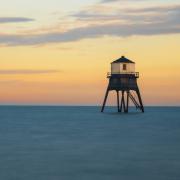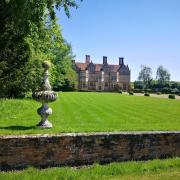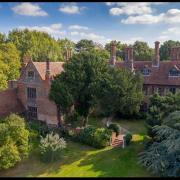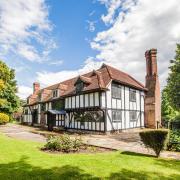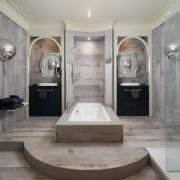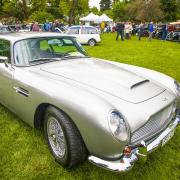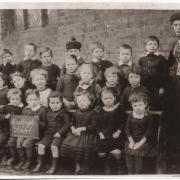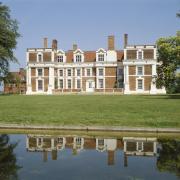Despite the continental-sounding name, Gustav Holst (1874-1934) was assuredly English, born on 21st September 1874 in Cheltenham where his father was an organist and piano teacher. He was actually born ‘Gustavus Theodore von Holst’ of Swedish antecedents (Swedish Dad, English Mum) but given the mutual antipathy existing between Britain and Germany before and during WW1 it was prudent to distance himself from the German-sounding surname which he did during the war. He’d become one of this country’s most famous composers of classical music and an accomplished teacher, the fourth generation of his family to make a living as a professional musician.
Holst conducted village choirs before entering London’s Royal College of Music on a scholarship in 1893. He studied under the Irish composer, Charles Villiers Stanford (1852-1924) and Bournemouth-born composer of the music for ‘Jerusalem’, Hubert Parry (1848-1918), but was prevented from pursuing a career as a concert pianist due to having neuritis in his hand. Holst said his right arm was: ‘Like a jelly overcharged with electricity’. Instead he learned the less dexterous trombone from the age of 12, performing in the Carl Rosa Opera Company, not as any old trombone but ‘First Trombone’. Later he joined the Scottish Orchestra. He also played the organ. In 1901 Holst married Emily Isobel Harrison (1876-1969), a chorister/soprano who’d be his partner until his death over 30 years later. They’d have a daughter, Imogen.
In 1905 Holst became music master at St Paul’s Girls’ School, London, and then in 1907 musical director at Morley College, also in London. A dozen years later he’d assume a similar role at Reading College (1919). He was a gifted teacher apparently. There is a suggestion of Holst treading sand as it took him time to find his composing style and he needed to earn a crust in the meantime. Establishing his own style meant resisting the influence of others including Wagner and Grieg plus abandoning an early liking for Hindu literature which infiltrated his opera, ‘Sida’, the ‘opera de camera’, ‘Savitri’ and the ‘Hymns from the Rig-Veda’. This was his so-called ‘Sanskrit’ period (1908-12). Holst also shared a passion for traditional English folk songs with his mate and fellow RCM student Ralph Vaughan Williams, and it was this inspiring his ‘St Paul’s Suite for Strings’ (1913). Holst was arguably one of the most original and versatile composers of his time what with Sanskrit, English folk, an interest in astrology (hence ‘The Planets’), being a fan of Gilbert & Sullivan et al. As Holst found his feet that style he developed was marked by clarity and economy.
If Holst is famous for one piece it’s his seven-movement suite ‘The Planets’ (1914-17) where each planet has its astrological associations converted into music: Mars (war), Venus (peace), Jupiter (jollity), Uranus (magic), Saturn (old age), and Neptune (mysticism), with Mercury, the Gods’ winged messenger the subject of the seventh movement. There was no Pluto as it wasn’t discovered until 1930. One tune taking flight from the suite is ‘I Vow to Thee my country’. A rugby anthem and remembrance tribute, it comes from ‘Jupiter’. The hymn tune was dubbed ‘Thaxted’ which Holst first came across in 1913 on a walking holiday (he enjoyed a good ramble), and he’d be bivouacking in a holiday/weekend cottage outside Thaxted, in Monks Street, which was ideal for rambling (and presumably composing), when he wrote ‘The Planets’. This was the work establishing him as a major composer. As this triumph was his magnum opus it’s easy to regard him as the classical world’s equivalent to pop’s ‘one hit wonder’ but this would be incorrect.


After he’d composed ‘The Planets’ Holst descended on Essex full time, becoming one of our own. He lived in the ‘Manse’ in Town Street in the centre of Thaxted between 1917-25, a small place noted for its church, St John’s, one of Essex’s most splendid with its impressively lofty spire, and its tower windmill, both standing sentinel. The 15th century Guildhall is also an impressive three-storied affair. The town, once important for cutlery, then a centre of the cloth trade, conceivably provided Holst with material for his compositions. The town developed a musical tradition which can be traced to Holst and his friend Conrad Noel (1869-1942), the so-called ‘Red Vicar’ of Thaxted’ who was well known for his Christian socialism but also liked a bit of church music and folk dancing. It was due to Holst there was a Whitsun festival in Thaxted with singers/players from St Paul’s and Morley appearing whilst he also wrote and arranged music specifically for the festival. Holst remained connected with Thaxted until his death whilst his daughter Imogen (1907-84), also a composer, maintained this association.
READ MORE: 24 hours in Thaxted: things to do, where to eat and property
Similarly majestic conceptions marked his ‘The Hymn of Jesus’ (1917) and the choral setting he conjured for Walt Whitman’s ‘Ode to Death’ (1919). If he’d been auditioning on ‘BGT’ the judges probably would have said he was a good storyteller. Holst showed his versatility with two comic operas; ‘The Perfect Fool’ (1921) and ‘At the Boar’s Head’ (1924) which evokes Shakespeare’s Falstaff. Another sea change saw something best described as ‘austere’, his orchestral piece ‘Egdon Heath’ (1927), which smacked of rural angst, inspired as it was by Thomas Hardy’s ‘The Return of the Native’. In the same year Holst first visited the States, his fame spreading around the globe; he even became a visiting lecturer at Harvard in 1932.
The ’Concerto for Two Violins’ (1929) won Holst the Royal Philharmonic’s Gold Medal. He died in London on 25th May 1934 aged 59 and was buried in Chichester Cathedral. It was a sad year for classical music which saw the passing of two other British composers, Edward Elgar and Frederick Delius. Imogen wrote a biography of her father (1938) followed by a study (1951). Holst was a shy man who didn’t welcome the fame courtesy of ‘The Planets’. When asked about his rationale for composing something Holst advised: ‘Never compose anything unless not composing it becomes a positive nuisance to you’.

CHRONOLOGY
1874: Gustavus Theodore Von Holst born in Cheltenham (21st September).
1893: Enters the Royal College of Music on a scholarship.
1901: Marriage of Gustav Holst to Emily Isobel Harrison who’d been one of his choristers.
1913: Holst first discovers Thaxted during a walking holiday.
1914: Holst begins writing ‘The Planets’, whilst residing in Monks Street, outside Thaxted.
1917: Gustav Holst moves to the Manse, Town Street, Thaxted in Essex (until 1925).
1918: ‘The Planets’ suite is first performed at the Queen’s Hall, London.
1921: ‘I Vow To Thee, My Country’ is created from Holst’s tune ‘Thaxted’.
1934: Death of Gustav Holst in London (25th May) aged 59.








